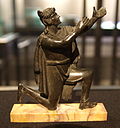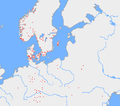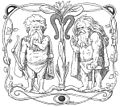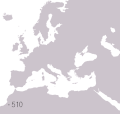Proto-Germanic paganism was the beliefs of the speakers of Proto-Germanic and includes topics such as the Germanic mythology, legendry, and folk beliefs...
72 KB (1,709 words) - 20:31, 8 July 2024
modern period. The northernmost extension of Germanic mythology and stemming from Proto-Germanic folklore, Norse mythology consists of tales of various...
30 KB (3,614 words) - 02:24, 30 August 2024
Continental Germanic mythology. It was a key element of Germanic paganism. As the Germanic languages developed from Proto-Indo-European language, Germanic mythology...
9 KB (973 words) - 19:50, 30 July 2024
The Germanic parent language (GPL), also known as Pre-Germanic Indo-European (PreGmc) or Pre-Proto-Germanic (PPG), is the stage of the Germanic branch...
11 KB (1,249 words) - 18:46, 12 July 2024
North and West Germanic folklore include elves, dwarfs, and the mare. (For more discussion on these entities, see Proto-Germanic folklore.) The great majority...
163 KB (20,239 words) - 17:52, 30 September 2024
from Norse sources (see Proto-Germanic folklore). Textual and archaeological sources allow the reconstruction of aspects of Germanic ritual and practice....
128 KB (15,974 words) - 14:56, 12 September 2024
Dragons, or worms, are present in Germanic mythology and wider folklore, where they are often portrayed as large venomous serpents. Especially in later...
24 KB (2,358 words) - 08:29, 29 August 2024
numbers in Germanic paganism. Both numbers (and multiples thereof) appear throughout surviving attestations of ancient Germanic folklore, in both mythology...
7 KB (868 words) - 21:53, 19 February 2024
Teutons (redirect from Teutons (Germanic tribe))
be interpreted as deriving from Proto-Celtic *towtā ('people, tribe'), or it may have been from a stage of Germanic language development prior to the...
15 KB (1,845 words) - 07:57, 21 July 2024
terms variously referred to stones, groves, and temple structures. From Proto-Germanic *harugaz, a masculine noun, developed Old Norse hǫrgr meaning 'altar'...
17 KB (1,594 words) - 11:57, 2 May 2024
Dutch: mare, Proto-Slavic *mara; mara in Old High German, Old Norse, and Swedish) is a malicious entity in Germanic and Slavic folklore that walks on...
19 KB (2,181 words) - 21:35, 12 August 2024
Germanic kingship is a thesis regarding the role of kings among the pre-Christianized Germanic tribes of the Migration period (c. 300–700 AD) and Early...
9 KB (1,164 words) - 18:26, 3 September 2024
derived from Proto-Germanic, spoken in Iron Age Scandinavia, Iron Age Northern Germany and along the North Sea and Baltic coasts. The West Germanic languages...
93 KB (9,514 words) - 11:22, 27 September 2024
Early Germanic culture was the culture of the early Germanic peoples. Largely derived from a synthesis of Proto-Indo-European and indigenous Northern...
124 KB (15,692 words) - 18:25, 7 August 2024
The Germanic peoples underwent gradual Christianization in the course of late antiquity and the Early Middle Ages. By AD 700, England and Francia were...
18 KB (2,309 words) - 10:09, 11 July 2024
Ptolemy: Geography Tacitus: Germania Proto-Indo-Europeans (Proto-Indo-European speakers) Proto-Germanics (Proto-Germanic speakers) Avarpi Burgundians / Burgundiones...
105 KB (6,522 words) - 03:59, 4 August 2024
hand–made pottery typical of that found in western Germanic groups, suggesting the presence of Germanic groups. The Chernyakhov people were primarily a settled...
18 KB (2,081 words) - 15:05, 24 August 2024
Elder Futhark (redirect from Common Germanic Futhark)
either a diphthong or a vowel close to [ɪ] or [æ]. z was Proto-Germanic [z], and evolved into Proto-Norse /r₂/ and is also transliterated as ʀ. The remaining...
33 KB (3,832 words) - 23:13, 5 August 2024
In Germanic paganism, the indigenous religion of the ancient Germanic peoples who inhabit Germanic Europe, there were a number of different gods and goddesses...
21 KB (696 words) - 14:51, 20 September 2024
Germanic philology is the philological study of the Germanic languages, particularly from a comparative or historical perspective. The beginnings of research...
4 KB (356 words) - 21:40, 9 March 2024
Arianism (section Among medieval Germanic tribes)
who were there were in agreement with the major theological points of the proto-orthodoxy, since at that time all other forms of Christianity "had by this...
87 KB (10,151 words) - 00:52, 22 September 2024
In Germanic mythology, an idis (Old Saxon, plural idisi) is a divine female being. Idis is cognate to Old High German itis and Old English ides, meaning...
5 KB (690 words) - 20:35, 17 March 2024
that derive from the Proto-Germanic language, which is generally thought to have emerged as a distinct language after 500 BC. Germanic culture is characterized...
8 KB (1,059 words) - 07:29, 3 June 2024
Harii (category Early Germanic peoples)
The Harii (West Germanic "warriors") were, according to a single brief remark by the 1st century CE Roman historian Tacitus, a Germanic people the most...
4 KB (476 words) - 23:57, 28 September 2024
Rune (redirect from Germanic rune)
wide variety of ways in modern popular culture. The name stems from a Proto-Germanic form reconstructed as *rūnō, which may be translated as 'secret, mystery;...
68 KB (6,974 words) - 11:19, 25 September 2024
dwarf (pl. dwarfs or dwarves) is a type of supernatural being in Germanic folklore. Accounts of dwarfs vary significantly throughout history; however...
41 KB (5,129 words) - 17:58, 30 September 2024
Germanic law is a scholarly term used to describe a series of commonalities between the various law codes (the Leges Barbarorum, 'laws of the barbarians'...
47 KB (5,889 words) - 11:41, 15 August 2024
studied by archaeologists. The Germanic Iron Age is divided into the Early Germanic Iron Age (EGIA) and the Late Germanic Iron Age (LGIA). It is particularly...
8 KB (1,007 words) - 18:04, 14 September 2024
their own power in much of the area of the Western Empire. In 476, the Germanic barbarian king Odoacer deposed the last emperor of the Western Roman Empire...
144 KB (19,301 words) - 06:06, 19 September 2024
Old Norse religion (redirect from North Germanic religion)
of Germanic religion which developed during the Proto-Norse period, when the North Germanic peoples separated into a distinct branch of the Germanic peoples...
104 KB (13,197 words) - 20:30, 30 August 2024























